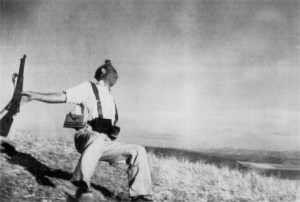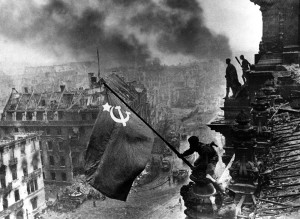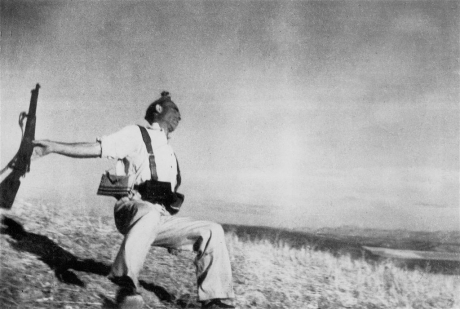…a note on photography, reality and history
In an article on the 3rd of October, the newspaper Politiken writes about an upcoming exhibition in the Barbican Art Gallery in London. The exhibition is supposed to shed new light on the old discussion about Robert Capas famous photo the fallen soldier: is it a fake or not?

Unfortunately, the article is not very helpful for those of us interested in photo-history. It says that “new negatives” will be exhibited. That sounds interesting, since it was announced at the beginning of 2008 that some new Capa-negatives was found in the so-called “Mexican suitcase“. However, the article goes on by saying that the person who “dug out” the negatives from the archives is Richard Whelan, the author of a well-known Capa biography. Since Whelan died 1½ year ago (which the newspaper doesn’t seem to have noticed), the evidence can hardly be newer than that – and thus not from the “Mexican suitcase”. In fact, from an interview with the curator, it seems like the exhibition will be much in line with the claims about the authenticity of the fallen soldier, which Whelan made in his well known 2002 article on the subject.
In an effort to bring the story up to date, the newspaper interviews a photographer, a photo-editor and a lecturer in media science about their views. Unfortunately, this part end up as it often does: pro or against Capa and his moral validity.
The photographer, Jan Grarup, dismisses Capa totally as being a charlatan. Instead, he points to the soviet war-photographer Jevgenij Khaldei as an example of a lesser known, but much better photographer. Jan Grarup is an eminent photographer, but in this case I think he is mistaken. It’s a bit ironic that he mentions Khaldei. No doubt he was a great photographer, who deserves to be remembered. But his most well known photo, that of two soldiers waving the red banner on top of the German Reichstag in May 1945, is in fact known to both staged and retouched.

More to the point: when we discuss pictures that are 60-70 years old, we must take into account that they are historical artifacts and take that context into consideration. When the first war photographs were taken, they were all staged – if not for anything else than for the simple reason of cameras being very slow and bulky. What we today consider as modern press photography was born in the inter-war period. It was aided by new, smaller and faster cameras as well as the boom in illustrated magazines. But in the end, it was the photographers – Capa, Khaldei and lots of others – who created and defined the new genre by what they actually did.
Granted, today there are press photographers who has lost their career do to photo manipulations that seems much more insignificant than the staging done by Capa and Khaldei. The rules have changed – and this, to my mind, is OK. But the interesting thing about Capa and Khaldei is not to use them to confirm what we suppose to be out present high moral stands. The interesting thing is to see them and their colleagues as historical figures in the gradual creation of modern press photo.
(The English version of this post is slightly shortened compared to the Danish version)

Spændende er det om sandheden om Capa´s billede af den faldne soldat nogensinde kommer frem.
Hvad angår Yevgeniy Khaldei´s rekonstruktion af flaghejsningen på Berlin´s Rigsdag er sagen klar. Den virkelige flaghejsning fandt sted d. 30. april 1945, sent om aftenen. Så sent at der ikke kunne fotograferes.
Dagen efter blev flaget fjernet af nazisterne.
Den 2. maj 1945, havde sovjettropperne erobret Rigsdagsbygningen, og Khaldei blev sat til at tage billedet, ved hjælp af to håndplukkede soldater. En af soldaterne skulle være fra Georgien, for at please Stalin.
Da Khaldei havde taget billedet, sendte han det til censuren på TASS, men fik det retur, med besked på at retuschere det.På den ene soldat´s håndled sås to armbåndsure. Det kunne betyde at de havde været på plyndringstogt.
Da Khaldei nu var i gang med penslen, benyttede han lejligheden til at tilføje de sønderskudte bygninger lidt ekstra granatrøg.
Det er et godt billede, meget dramatisk, men absolut ikke autentisk. Synd at en så god fotograf som Khaldei blev miskrediteret på denne måde.
Iøvrigt var Yevgeniy Khaldei ikke krigsfotograf. Han var kampsoldat med besked på at tage billeder, når lejlighed bød sig.
mvh. Christen Hansen.
Tak for kommentaren, Christen. Jeg må vist ha’ kigget lidt mere på Khaldei 😉